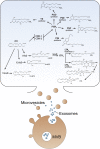Extracellular vesicles and their content in bioactive lipid mediators: more than a sack of microRNA
- PMID: 29678959
- PMCID: PMC6210911
- DOI: 10.1194/jlr.R084640
Extracellular vesicles and their content in bioactive lipid mediators: more than a sack of microRNA
Abstract
Extracellular vesicles (EVs), such as exosomes and microvesicles, are small membrane-bound vesicles released by cells under various conditions. In a multitude of physiological and pathological conditions, EVs contribute to intercellular communication by facilitating exchange of material between cells. Rapidly growing interest is aimed at better understanding EV function and their use as biomarkers. The vast EV cargo includes cytokines, growth factors, organelles, nucleic acids (messenger and micro RNA), and transcription factors. A large proportion of research dedicated to EVs is focused on their microRNA cargo; however, much less is known about other EV constituents, in particular, eicosanoids. These potent bioactive lipid mediators, derived from arachidonic acid, are shuttled in EVs along with the enzymes in charge of their synthesis. In the extracellular milieu, EVs also interact with secreted phospholipases to generate eicosanoids, which then regulate the transfer of cargo into a cellular recipient. Eicosanoids are useful as biomarkers and contribute to a variety of biological functions, including modulation of distal immune responses. Here, we review the reported roles of eicosanoids conveyed by EVs and describe their potential as biomarkers.
Keywords: cancer; eicosanoids; exosomes; microvesicles; neutrophils; platelets.
Copyright © 2018 Boilard.
Conflict of interest statement
There is no conflict of interest to disclose.
Figures



Similar articles
-
Circulating Extracellular Vesicles As Biomarkers and Drug Delivery Vehicles in Cardiovascular Diseases.Biomolecules. 2021 Mar 5;11(3):388. doi: 10.3390/biom11030388. Biomolecules. 2021. PMID: 33808038 Free PMC article. Review.
-
Extracellular Vesicles: New Endogenous Shuttles for miRNAs in Cancer Diagnosis and Therapy?Int J Mol Sci. 2020 Sep 4;21(18):6486. doi: 10.3390/ijms21186486. Int J Mol Sci. 2020. PMID: 32899898 Free PMC article. Review.
-
Transcriptome of Extracellular Vesicles: State-of-the-Art.Front Immunol. 2019 Feb 28;10:202. doi: 10.3389/fimmu.2019.00202. eCollection 2019. Front Immunol. 2019. PMID: 30873152 Free PMC article. Review.
-
Focus on Extracellular Vesicles: New Frontiers of Cell-to-Cell Communication in Cancer.Int J Mol Sci. 2016 Feb 6;17(2):175. doi: 10.3390/ijms17020175. Int J Mol Sci. 2016. PMID: 26861306 Free PMC article. Review.
-
Extracellular vesicles characteristics and emerging roles in atherosclerotic cardiovascular disease.Metabolism. 2018 Aug;85:213-222. doi: 10.1016/j.metabol.2018.04.008. Epub 2018 May 1. Metabolism. 2018. PMID: 29727628 Review.
Cited by
-
Platelets and extracellular vesicles and their cross talk with cancer.Blood. 2021 Jun 10;137(23):3192-3200. doi: 10.1182/blood.2019004119. Blood. 2021. PMID: 33940593 Free PMC article. Review.
-
The role of microvesicles and its active molecules in regulating cellular biology.J Cell Mol Med. 2019 Dec;23(12):7894-7904. doi: 10.1111/jcmm.14667. Epub 2019 Sep 27. J Cell Mol Med. 2019. PMID: 31559684 Free PMC article. Review.
-
Targeted Lipidomics for Characterization of PUFAs and Eicosanoids in Extracellular Vesicles.Nutrients. 2022 Mar 22;14(7):1319. doi: 10.3390/nu14071319. Nutrients. 2022. PMID: 35405932 Free PMC article.
-
Phosphatidylcholine-Derived Lipid Mediators: The Crosstalk Between Cancer Cells and Immune Cells.Front Immunol. 2022 Feb 15;13:768606. doi: 10.3389/fimmu.2022.768606. eCollection 2022. Front Immunol. 2022. PMID: 35250970 Free PMC article. Review.
-
Platelet extracellular vesicles in COVID-19: Potential markers and makers.J Leukoc Biol. 2022 Jan;111(1):63-74. doi: 10.1002/JLB.3MIR0221-100R. Epub 2021 Nov 3. J Leukoc Biol. 2022. PMID: 34730839 Free PMC article. Review.
References
-
- Ridger V. C., Boulanger C. M., Angelillo-Scherrer A., Badimon L., Blanc-Brude O., Bochaton-Piallat M. L., Boilard E., Buzas E. I., Caporali A., Dignat-George F., et al. . 2017. Microvesicles in vascular homeostasis and diseases. Position Paper of the European Society of Cardiology (ESC) Working Group on Atherosclerosis and Vascular Biology. Thromb. Haemost. 117: 1296–1316. - PubMed
-
- Colombo M., Raposo G., and Thery C.. 2014. Biogenesis, secretion, and intercellular interactions of exosomes and other extracellular vesicles. Annu. Rev. Cell Dev. Biol. 30: 255–289. - PubMed
-
- Record M., Subra C., Silvente-Poirot S., and Poirot M.. 2011. Exosomes as intercellular signalosomes and pharmacological effectors. Biochem. Pharmacol. 81: 1171–1182. - PubMed
-
- Jimenez A. J., Maiuri P., Lafaurie-Janvore J., Divoux S., Piel M., and Perez F.. 2014. ESCRT machinery is required for plasma membrane repair. Science. 343: 1247136. - PubMed
Publication types
MeSH terms
Substances
Grants and funding
LinkOut - more resources
Full Text Sources
Other Literature Sources

